iChing
If I’m stuck on a difficult decision, I use the I Ching. When I mention this to people, many of them don’t know what the I Ching is. I’m not entirely sure I fully understand it myself, or why it works, but I use it anyway, and I’d like to share it.
Tom was like Hannibal Lecter. Not this Hannibal Lecter:

But this Hannibal Lecter:

Tom was an elderly English gentleman, cultured and refined, with white hair and a white moustache. He looked like he’d been in his fifties for at least three decades. He was my English teacher when I was fourteen. Not a cannibal—at least, as far as I know.
“What is the value of imprisoning people, Damaso?” he would ask, waiting patiently while I painstakingly articulated my sentences. He would gaze out the window of the small living room where we had our sessions, in the Goya district of Madrid. Is he even listening? I wondered. He certainly was, as he proceeded to rip apart my grammar and arguments. He threw complex topics at me—*“What do you think of democracy?”*—and toyed with me as though I were an innocent Clarice. Those conversations were probably the best I’ve ever had: my abilities stretched, my assumptions challenged, my capacity to reason expanded.
One day, I walked into the room and found Tom reading the I Ching. “*What book is that?*” I asked. “*It’s the I Ching, an ancient Chinese text that encapsulates the core of Chinese thought. It’s fascinating, but not for you… at least, not yet,*” he said with a smile. I didn’t give it much thought. We moved on with the class, and eventually, I moved on with my life. Classes ended, and I lost contact with Tom. By the time I realized the significance of those sessions, it was too late—I had lost any clue that would allow me to reconnect. “*You remind me of myself at your age,*” he once said, and only now do I understand what a compliment that was.
30 years later (30 years!), one guy in my team decides to call one project Dharma. Not because of the Hindu term but because of the Dharma Initiative from the Lost TV show.
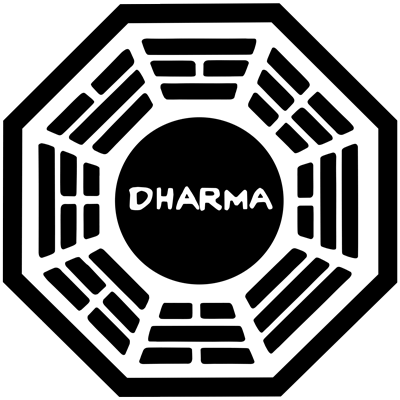
But… where have I seen those lines before? That combination of broken and unbroken lines? Someone on Reddit had the same question (always):

Someone in Reddit had the answer (always):

If you enter that rabbit hole, you reach:

Oh, wow 😮! Isn’t this the book Tom was reading, like, forever ago? This must be a sign ✨!
I bought the book. There are many different versions and translations, but this one is mine.
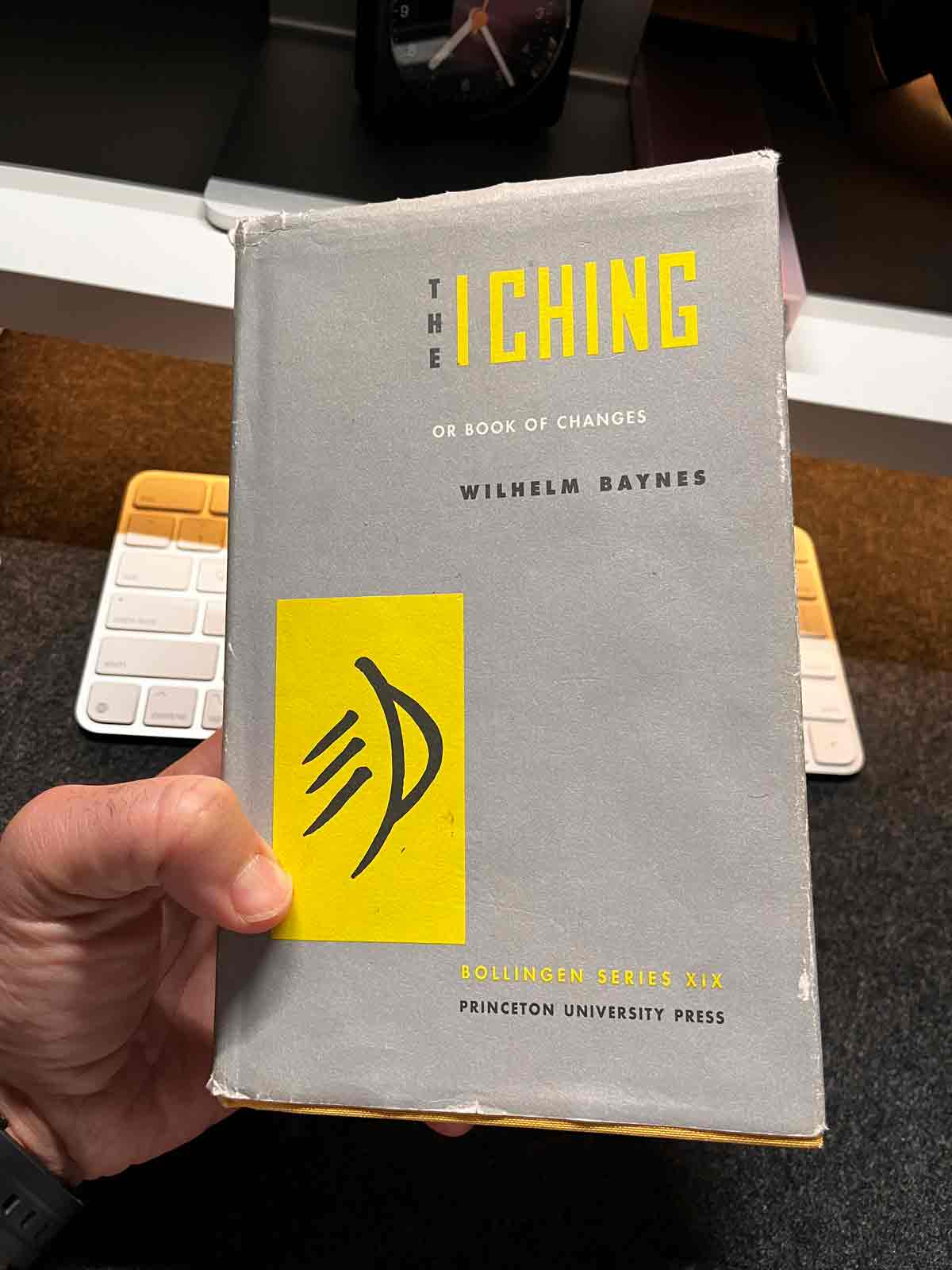
The foreword by Carl Jung hit me deep.
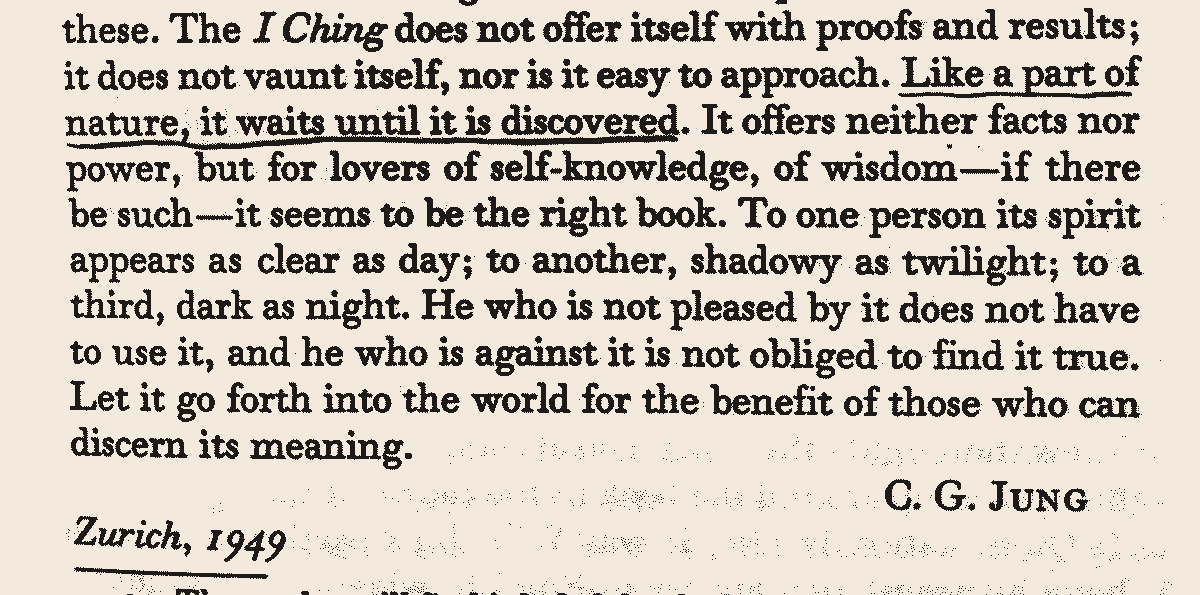
Well… the wait was over.
The book starts like a game, with all the glyphs and tables:
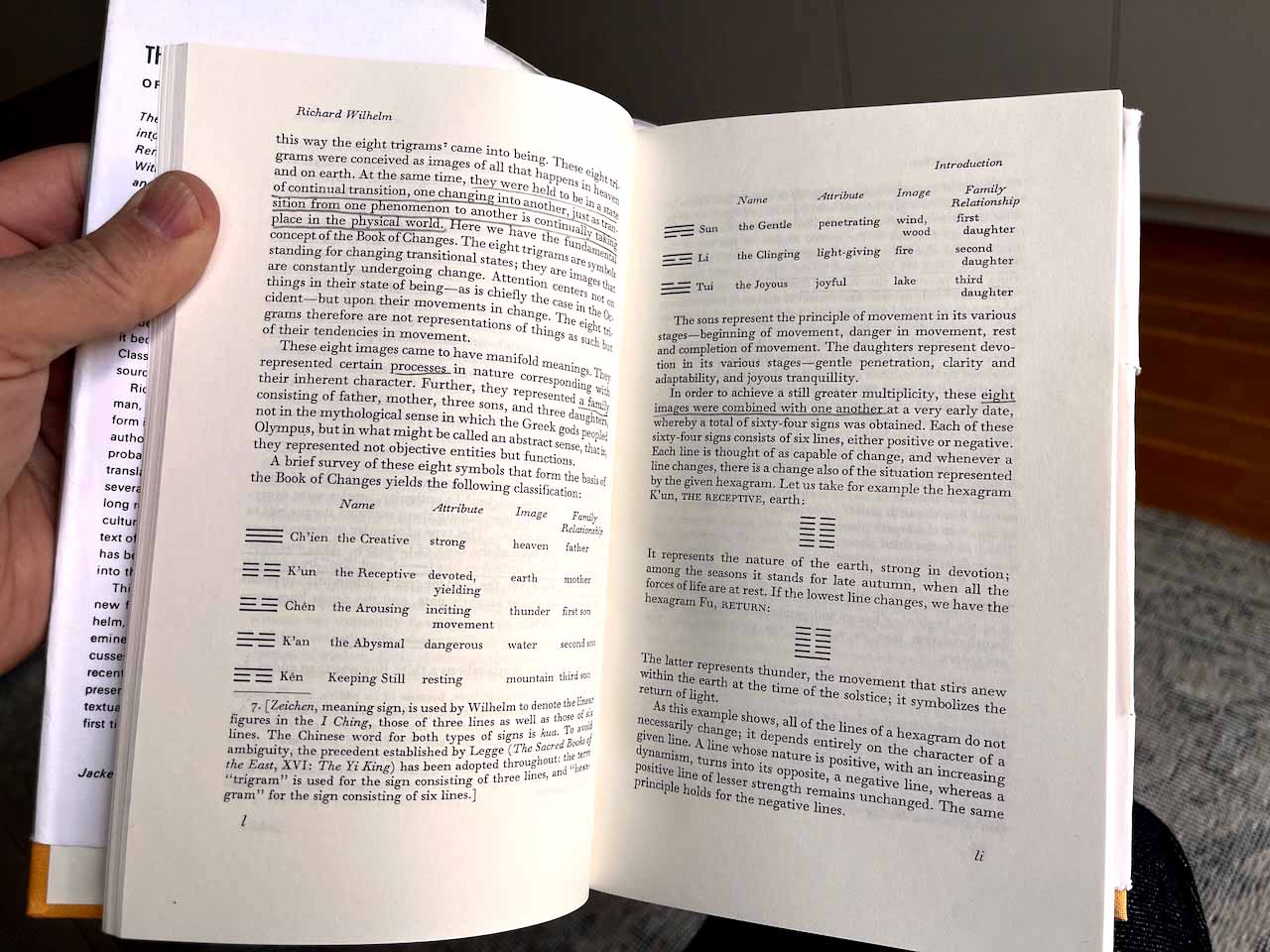
Gets a bit weird:
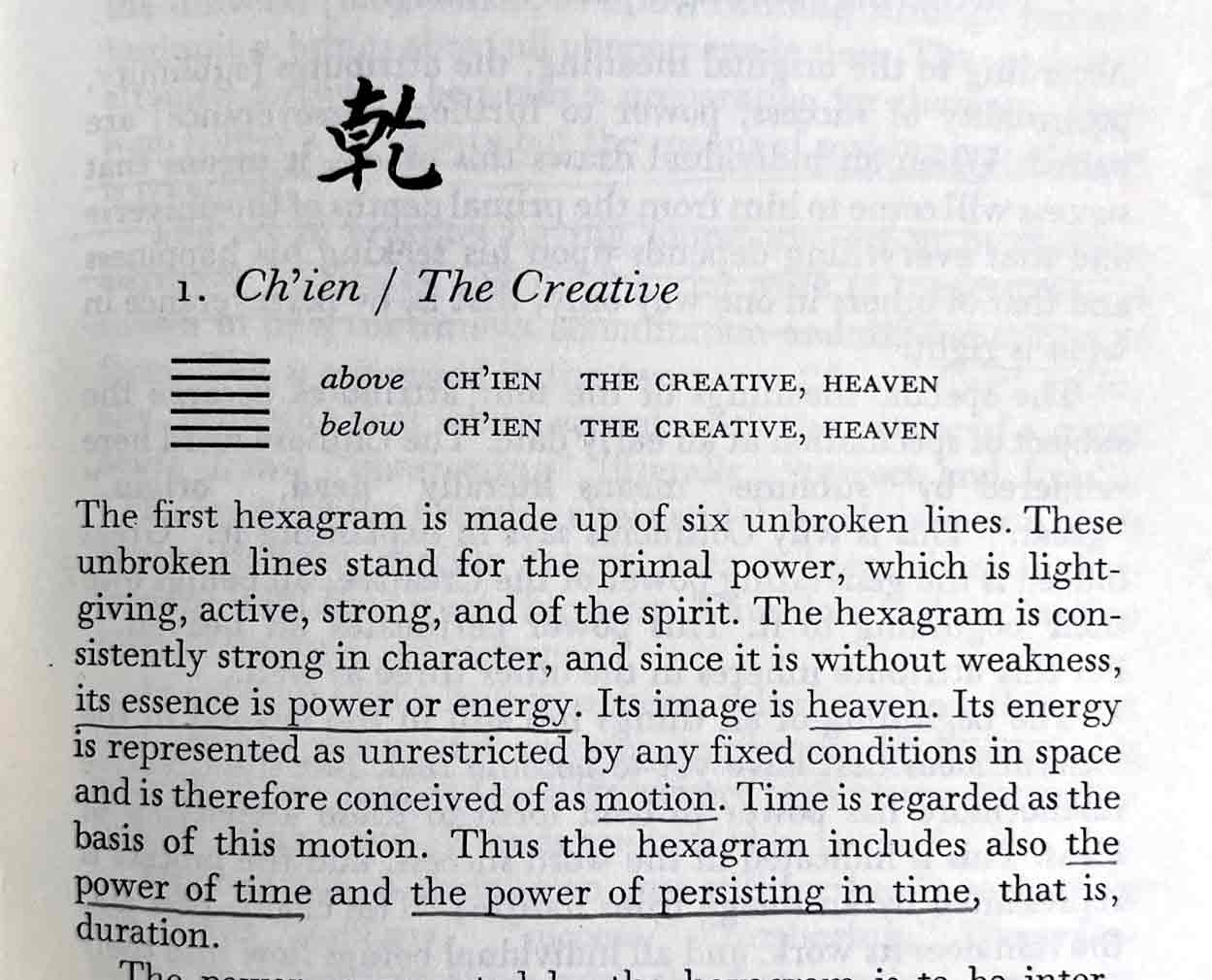
Ultimately it blows you away:
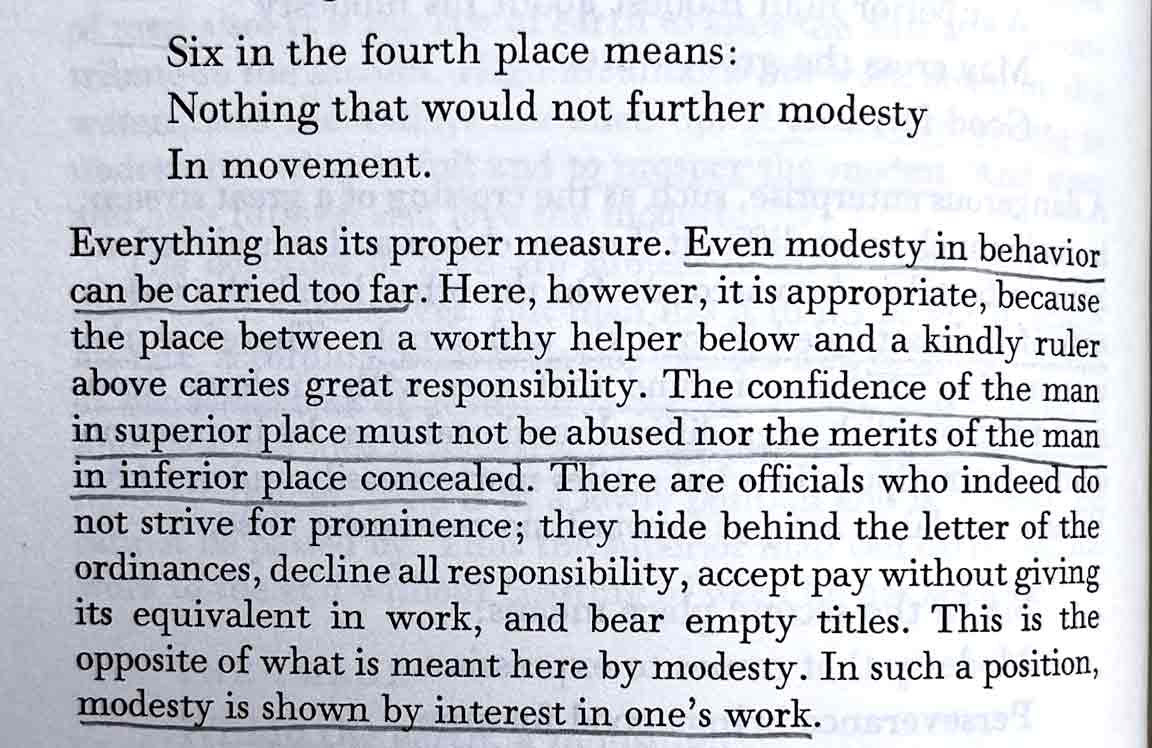
I read it front to back. It feels like receiving counsel from ancient, wise sages. Everything is condensed into short chapters that describe particular situations and their underlying dynamics. The Art of War, a far more popular Chinese book, now feels like a summary—an application of the principles of the I Ching to warfare. A derivative work. The I Ching is the original source of truth.
The worldview behind the I Ching
The foundational belief upon which the book is built is that the world is in constant flux, shifting from one condition to another in patterns as inevitable and natural as the changing seasons.
The book helps you understand:
- What situation you’re in.
- Which forces are at play.
- How particular actions lead to specific outcomes.
That’s why it’s also called The Book of Changes.
Think of it like surfing:
We cannot control the waves of an ocean,
but if we learn how to read the sea,
and learn how to ride the waves,
we can be carried by the tides
instead of crushed by them.
I think this is profoundly true. The world ebbs and flows on its own, completely indifferent to your insignificant existence. You’re not devoid of agency, of course, but your agency is most powerful when aligned with these larger dynamics.
I’ve said it time and again: everything comes down to _presence and will_—the presence to truly understand the moment, and the will to do what is needed.
The mechanics of the oracle
Reading the book on its own is already an enlightening experience, but it actually comes with a remarkable perk: the book is an interactive device, not merely a passive object. With the proper ritual, you can prompt the book—and it will respond.
I know, I know.

I’m going to frame it like this. There’s a spectrum of approaches to this:
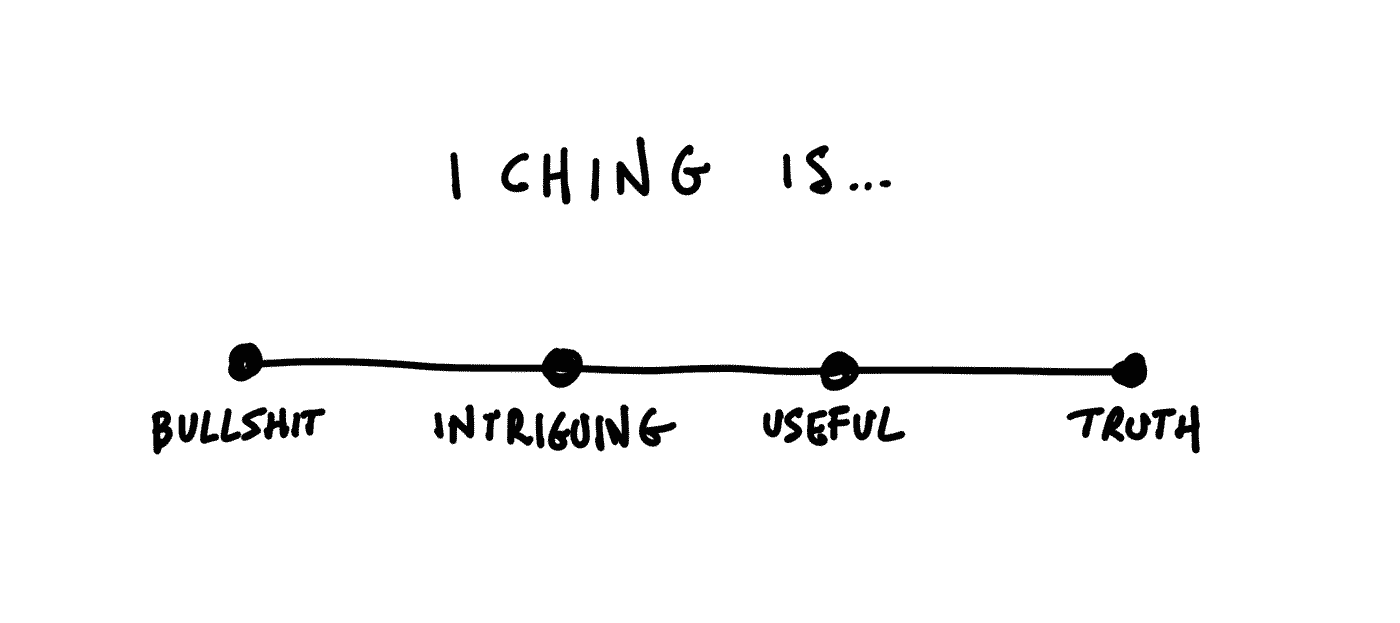
- On the far left, you see this as pure nonsense—something akin to astrology.
- A bit to the right, it’s still nonsense, but now you’re curious.
- A bit further right, you recognize it as a useful tool for lateral thinking: something that shakes you out of the autopilot of your well-established neural pathways and forces you to approach situations from a fresh perspective.
- On the far right, you believe the universe is a web of interdependent processes; that “randomness” is just the name we’ve given to our inability to fully grasp complexity; and that interpreting a seemingly random event reveals truths we’re not equipped to rationally decode. It’s better, therefore, to trust it implicitly, as it computes insights that surpass our intellect.
How is it done?
Prompt the oracle. Write down your question—don’t rely on memory. Make sure your words are clearly recorded, so you can revisit them later, word for word, exactly as you asked them.
Then perform the reading. There are two methods: straws and coins. I don’t even know what the straws are—just use the coins. You need three coins. Heads and tails, 0s and 1s, you get the idea. Toss all three coins at once. If there are more tails (0s) than heads (1s), draw a yang line, an unbroken line (–––––). Otherwise, it’s a yin line, a broken line (–– ––). If, by chance, all three coins land as heads or tails, that’s a moving line—just mark it with an asterisk ( * ) next to it.
You’re going to need six lines. Two to the power of six is sixty-four. The I Ching relates your question to one of these sixty-four hexagrams—each one representing a unique situation. You draw the lines from the bottom up: Line 1 is at the bottom, and Line 6 is at the top.
At the end of the six draws, you’ll have six lines in your notebook—some unbroken, some broken, some moving, some stable. You’ve received your answer: the I Ching has spoken.

Open the book and locate the number of your hexagram. Read it carefully. Try to draw a connection between your question and the situation described. Reflect on the hexagram—its judgment, its image, and its commentary. You’ll find the meaning there.
You are not finished, though.
If any of your lines are moving lines, read their commentary as well—they are particularly relevant to your situation. Once you’ve done this, invert those moving lines: broken lines become unbroken, and vice versa. You’ll now have a second hexagram, representing the situation toward which you’re heading. Locate that hexagram and read its judgment and image carefully.
You now have a complete reading: the character of your current situation (the original hexagram), its most pressing drivers (the moving lines), and the new situation you’re moving toward.
Make up your mind—choose your course of action.
Digitizing the I Ching
I wanted to create a digital version of this. I don’t always have three coins handy, and I certainly can’t carry a massive book around all the time. But the key challenge was this:
Can I make a digital version of the I Ching without losing its magic?
Of course, I can digitally generate a random number between 1 and 64 to select a hexagram—but will it carry any significance? When you toss the coins with a question in mind, that seemingly random result is tied directly to your physical and mental state at the exact moment you throw them. This is what creates the significance. Whether you sincerely believe the Universe communicates through synchronicity or you’re simply curious, removing the connection between your physical action and the result erases the magic. You’ll never feel the Universe is speaking to you; you won’t even experience the doubt that it might be.
So here’s what I did:
I offer you a text box to prompt the oracle. While you’re typing your question, I record the timestamp of each keystroke with millisecond precision. This gives me plenty of margin to treat the least significant digits of the timestamp as a highly random event. Humans typically type with intervals of hundreds of milliseconds, so capturing the millisecond digit and checking whether it’s even or odd is essentially as random as tossing coins.
Each keystroke represents a coin toss, and every three keystrokes allow me to compute a single line of the hexagram. Since a hexagram consists of six lines, I need you to press at least eighteen keys to generate a complete reading. In practice, reaching this threshold has never been an issue.
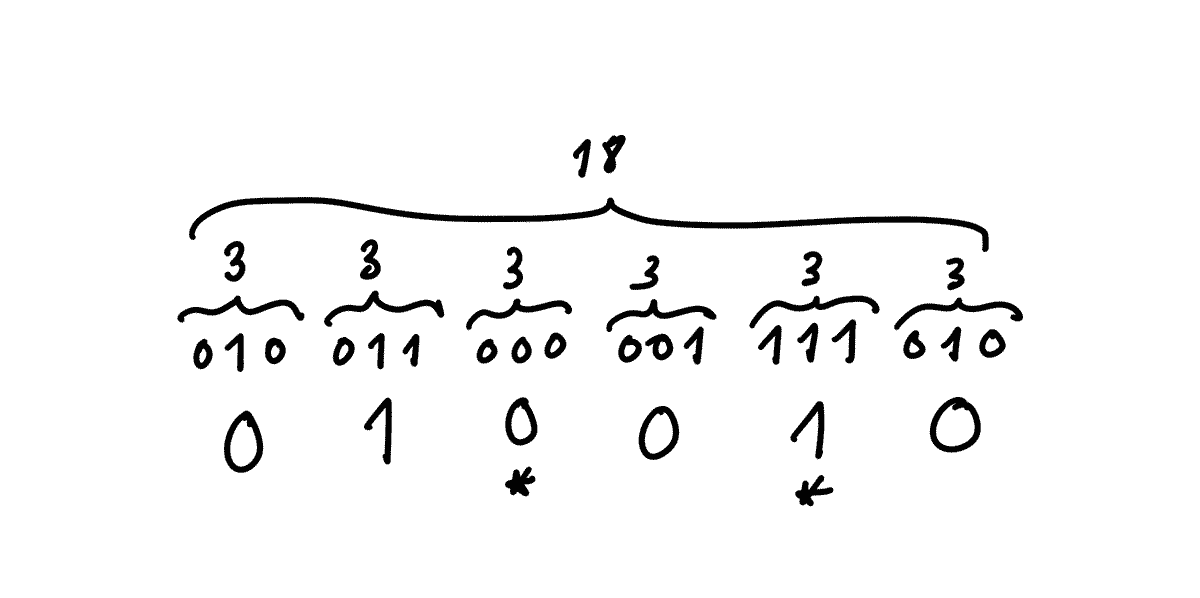
What happens if your question is longer? I simply create another array and combine it with the previous one before computing the final result. That’s why I need you to finish typing your prompt completely before delivering the reading. Every letter, every space, every backspace counts—your reading will reflect all of it. In some ways, I even consider this method more appropriate than the traditional coin toss, although it’s certainly less theatrical and romantic.
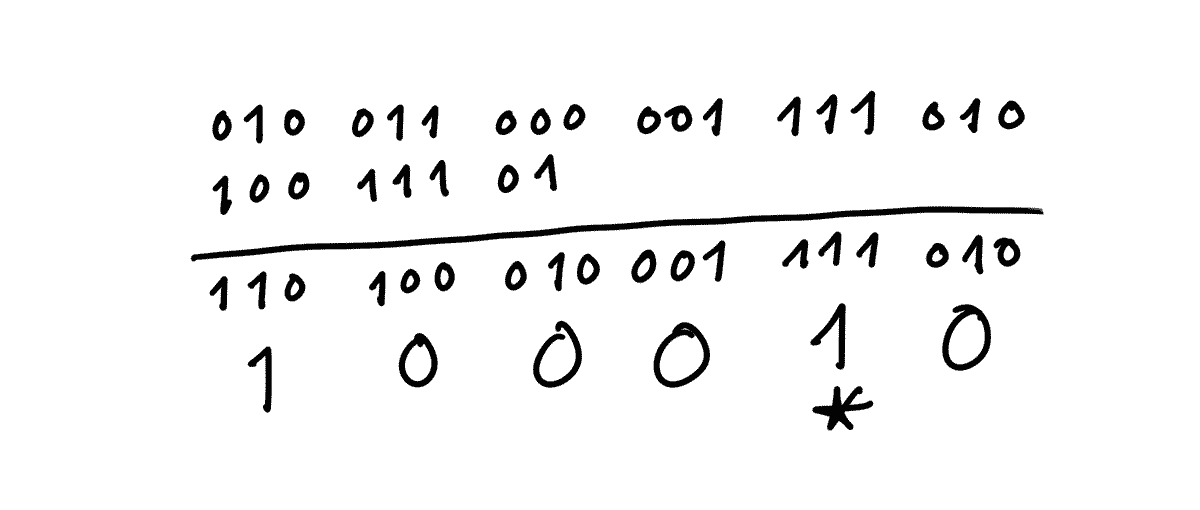 I’ve been using my digital I Ching (my iChing?) for quite a while now, but I’ve decided it’s finally time to polish it and share it with others—an excuse to vibe code something and learn a bit along the way.
I’ve been using my digital I Ching (my iChing?) for quite a while now, but I’ve decided it’s finally time to polish it and share it with others—an excuse to vibe code something and learn a bit along the way.
You can access the iChing here.
The UI and the AI
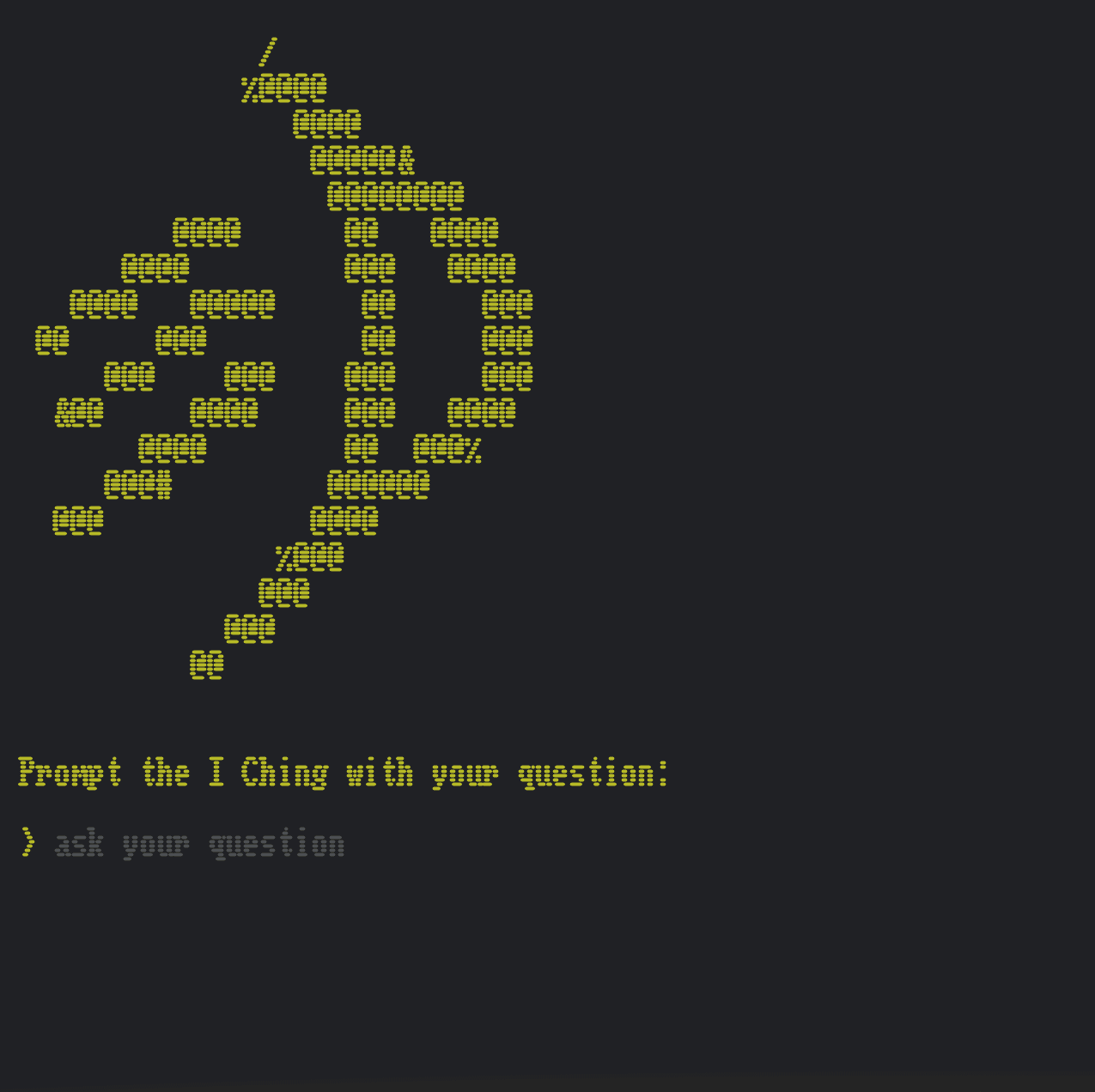
The retro look is a homage to the hatch that inspired this whole thing in the first place.
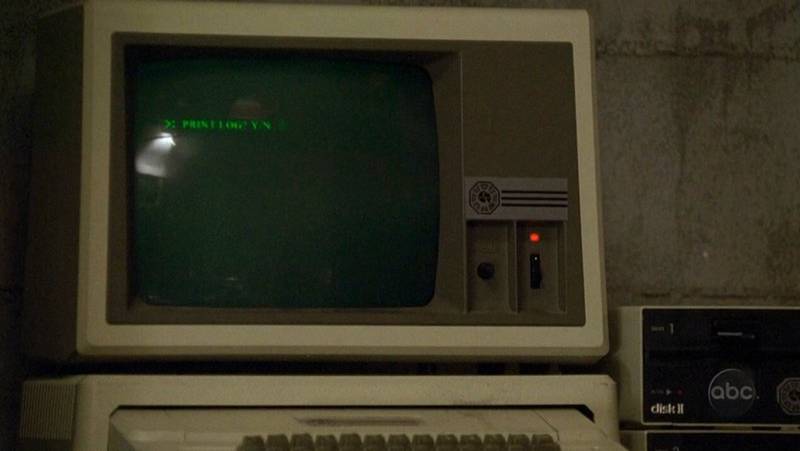
In any case, it also works because the I Ching speaks from a time long past—so it’s fitting that its interface is the command line.
When you toss the coins, you must carefully craft each line, identify the hexagram, and then search for it within the pages of the book. This process creates a certain tension—a sense of anticipation—as you wait for the answer. I tried to emulate that feeling by revealing the response letter by letter. It’s totally unnecessary, but I ended up loving it. Also, it resembles how AI chatbots deliver their answers. And after all, isn’t this precisely what we’re doing—prompting an unknowable Universal Intelligence for advice?
Speaking of AI, I discovered that ChatGPT is quite familiar with the I Ching. I even created a custom GPT for this—it’s linked at the bottom of the answer. If you copy and paste the summary response into this GPT, you’ll receive a detailed description of the hexagrams and their lines. Now you don’t even need the physical book to understand each hexagram’s meaning. However, it’s still a shortcut: you won’t fully grasp the nuance of the system without deeper study.
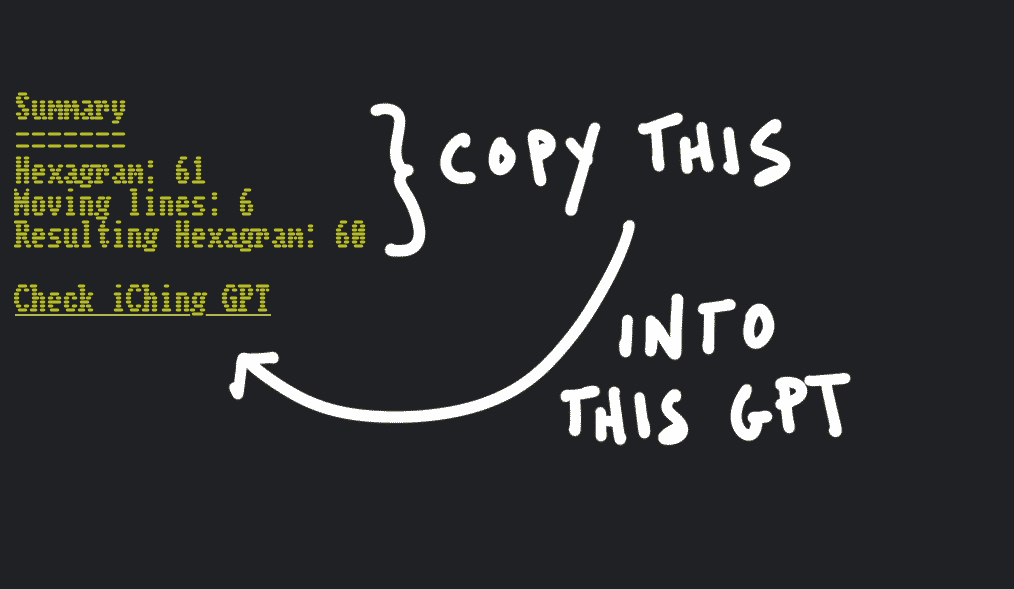
Interestingly, I tested the GPT and found that if you provide both the summary and your original question, it will handle everything for you—including interpreting how the hexagram relates specifically to your question. However, I decided to remove this feature. The true value of the I Ching is in making you reflect on the relationship between what’s described and the concrete question you’ve asked. It’s precisely through this realization that the I Ching awakens you. Having someone else establish that connection defeats the entire purpose.
I’m pretty sure this dichotomy—whether to let the AI handle everything or retain some human agency, a human in the loop—will be the defining theme of the months ahead.
I hope you find this useful!
